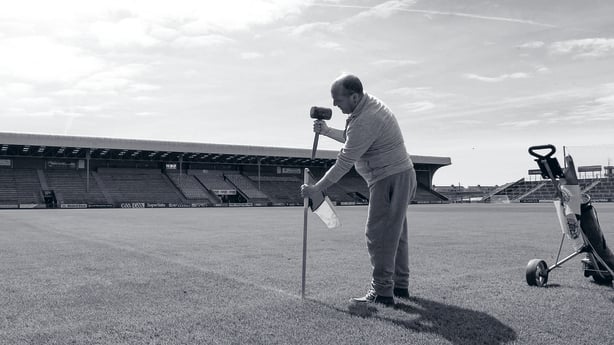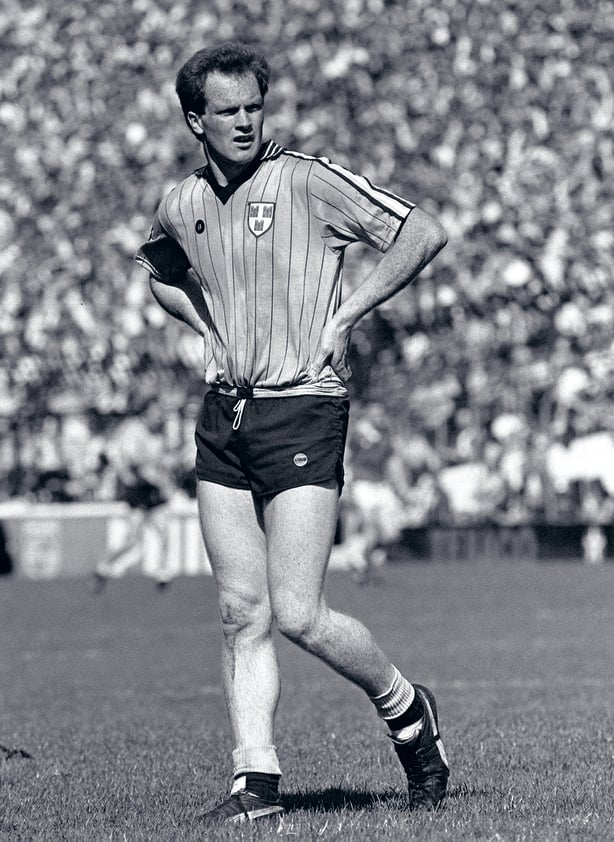We present an extract from Threads, the new book from celebrated GAA football player turned fashion designer Paul Galvin.
Taking the clothes they wore as a starting point, in his first book Paul Galvin skilfully weaves together a collection of stories of Irish men who defined the culture and mood of their time.
In 'Push' he tells the story of the legendary Walker Brothers – cyclists and soldiers who pedalled through a storm for Ireland at the 1912 Stockholm Games. In ‘Born Mad’, discover another side to Samuel Beckett – sartor and prolific sportsman who had knockout power as a champion boxer in school. In ‘Boland’ we learn about Harry Boland’s background as a trained tailor, and in ‘Jack’ we encounter Jack B. Yeats at the Olympic Games in Paris.
These are just some of men who have inspired Paul’s own fashion collections and whom he writes about here in a fascinating collection that shines a light on how history is woven into the clothes Irishmen wear.
The GAA groundsman – designer and geometrician
The GAA pitch, fully lined and cut, is an exercise in design. Geometric, perfectly proportioned, easily-read and understood, pitches are made to measure – like a tailored suit. Lined with chalk at precise intervals around the parallelograms – or the big square and the small square, as GAA geometricians like to say – the D, the sidelines, the playing lines at 13, 21, 45 and 65 metres, the dash at midfield and the end-lines. There are shapes, proportions, angles, distances, volumes, letters, numbers and graphic design at play. There are 15 rectangles to be found between the lines of a pitch. The first 10 letters of the alphabet, A to J, can be spelt out by the lines on a GAA pitch. Of the remaining letters, L, O, P, Q, R, S, T, U and V can also be spelt out by the lines, as can the whole numbers 0 to 9. The groundskeepers at every GAA club around the country are designers and teachers of sorts. Either way, there is a lot of reading to be done between the lines of any GAA pitch. There's art, maths and English on the grass. Our understanding of Gaelic games lies on, along, over and in between these lines.
All the GAA groundskeepers I know are cut from a different cloth. They are tuned to a different frequency. They tend to be flinty and smart, and enjoy a close relationship with nature. Vince Linnane was the groundsman at Austin Stack Park in Tralee for 28 years. Vince was friendly with an uncle of mine. He came from Mayo but was married to Kerry; not only to his wife, who was from Ballyduff, but also to the grass, soil and divots of Kerry. Vince was the groundsman and the kit man so he knew a lot about important things like the pitch and the jersey. Groundskeepers like those at the major GAA grounds in Ireland were discussing sustainability long before most people. They cared for and protected the grass, the soil, the worms and the birds. Every time they ran a gang of young fellas off a playing pitch with a roar, a clenched fist, a veiled threat or by driving a tractor lawnmower in their direction at top speed, they were practising early sustainability. I consider them designers too. They understand sward, colour and dimension, lining the pitch according to standard guidelines, and placing brand logos, club crests and numbers where they must. They measure grass length and match sward colours, creating a visual display for spectators while facilitating the playing of the game. If this doesn’t demonstrate an intrinsic link between design and sport, what does?

Groundskeepers at more high-profile stadia around the world are highly educated. They are scientists – multi-disciplinary experts in biology, horticulture, climate, nature and design. They shape and cut the grass in patterns, create landscapes, and ensure balance, proportion and perfect geometry or trigonometry. They are geographers and environmentalists. To the groundskeeper, grass is more important than any player or match. Stuart Wilson, head groundskeeper at Croke Park, previously worked at Arsenal’s state-of-the-art Emirates Stadium and the Aviva Stadium. As part of his daily responsibilities at Croke Park, Stuart must consider air and soil temperatures, photosynthesis, moisture and salinity, across a playing pitch 145 metres long and 88 metres wide. In conjunction with Dublin City University and experts from STRI (Sports Turf Research Institute), the Croke Park pitch is regularly tested for firmness, torque and traction. To determine grass length, balls are dropped from 2 metres to test rebounding. A studded metal 30 kg plate is dropped onto the pitch to replicate what STRI deems to be the downward force exerted by a player as they sprint. The Longchamp penetrometer, used to gauge the 'going’ at race tracks, is also used on the Croke Park pitch. Groundskeeping today requires knowledge of the natural environment, climate, science, technology and design in one.
The ‘going’ on a GAA pitch – that is, grass length, sod firmness, traction and absorbency – and the measurement of the pitch lines are of particular importance to free-kick takers in Gaelic football. A free-kick taker reads the lines of the field, measures distances and judges angles and arcs every time they place a ball for a free-kick. Each free-kick is made to measure, tailored specifically to the requirements of the situation. The pre-kick routine is an exercise in design in a way. The kick is pre-designed and measured in the mind. If the mental design and measurements are correct, the free will be successful. Like in the tailoring of a suit, leg length plays a key role as the free-taker custom-makes the kick. So does stud length. Football boots have a standard stud length, and the grass is usually a similar standard length; if there is an art to free-taking, it may be fixed to the player’s ability to brush the grass with the stud at just the right depth. If the standing foot is planted here, the kicking foot should fall on the ball there, meeting the underside at an angle, brushing the grass and sending the ball on a certain trajectory, curling to a precise arc, travelling the correct distance and falling between the goalposts.

Dublin’s Dean Rock is the preeminent free-taker in the game today. Dean’s father, Barney, also took frees for Dublin in the 1980s. Barney’s grandfather, William Rock, served as a groundskeeper in Croke Park across the 1950s and 1960s. William was also in charge of the Croke Park match balls on game day. Dean and Barney Rock’s forefather handled the match-day footballs and measured and laid the pitch lines that years later Dean and Barney themselves measured as free-kick takers.
After 31 seconds of the 1962 All-Ireland football final between Kerry and Roscommon, Kerry’s Garry McMahon from Listowel scored the fastest-ever goal in an All-Ireland final. As the ball went in, the camera cut to a man in the crowd wearing a top hat, white penny collar shirt, perfectly tied black tie and black overcoat. He was dressed like a tailor or a landlord – and was both in a way. He was William Rock. This record stood until the 2020 final, when a goal was scored after 13 seconds. The scorer this time was Dean Rock.
Garry McMahon was the son of Listowel playwright, Bryan MacMahon, an esteemed teacher, a principal, poet, novelist and bookshop owner. Along with John B. Keane, Bryan founded Listowel Writers’ Week. Among his written publications is an English translation of the Irish-language autobiography of Peig Sayers. Bryan was one of the few settled people capable of speaking Shelta, the language spoken by Irish Travellers. He once said that ‘writing is a man or woman pausing to embroider life’.
If clothes and the Irishman are part of the same woven history, then men like the MacMahons and William Rock are the tailors.

Threads: Clothes and the Irishman – A Woven History is published by Gill

